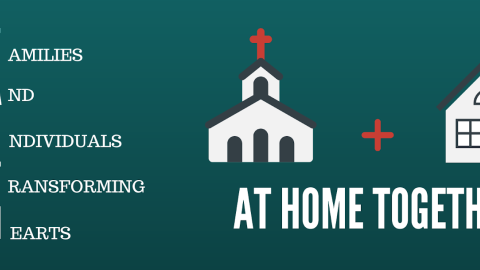Faith Nurture, Intergenerational Ministry
Faith at Home . . . Together

Belonging. In today’s COVID church world, there’s a lot of talk about how to stay connected to each other. Many churches are not yet back to meeting in person, and those that are have likely nixed their coffee time and other fellowship opportunities. Faith formation activities look different or have stopped, there’s less visiting of the elderly and ill. Congregations feel disconnected and out of sorts, and church leaders are fretting about not being able to help form faith in their members.
As the first of the four Building Blocks of Faith, “Belonging” is described this way:
I belong to God and to God’s family, the church. We all have a deep need to belong. That’s why the first question and answer of the Heidelberg Catechism is about comfort and belonging: “. . . I am not my own, but belong—body and soul, in life and in death—to my faithful Savior, Jesus Christ.” We are people who belong to God and also to a community, the church. We are created with a longing to connect to God and with his people. We are also hardwired to live with and learn from other people. So God graciously places us with brothers and sisters in Christ. With them we worship and serve, share our joys and our sorrows, and learn about what it means to be the people of God.
But how do we help people feel connected to a church body that is unable to connect like we used to?
Connecting a Congregation
My home church of Pease CRC in Pease, Minnesota, spent many hours contemplating this question recently. We came up with the idea of a church-wide at-home faith formation initiative called “Faith at Home Together.” The idea was to provide a simple-to-follow daily faith activity that could be used in any household.
The hope is that the congregation will feel connected to each other in the 10-15 minute act of reading the same scripture on Monday, praying the same prayer on Tuesday, doing the same activity of gratitude on Wednesday, answering the same faith question on Thursday, and doing the same act of service on Friday.
Members are encouraged to do these activities with their families, do them over the phone with their friends, or do them by themselves. Separately, but together. A “kit” filled with instructions, supplies, and treats was handed out or delivered to each household, and weekly emails to remind and encourage will go out from the church office. We’ve even started a private Facebook group for people to post their thoughts, questions, and pictures of themselves doing the activities.
Stay Tuned!
At this point, you’re probably wondering how it’s going. Well, I’ll let you know as soon as I know! It’s all slated to start on October 4, and it will run through the end of the year. But so far, people seem excited, and the kits were met with smiles and gratitude.
If you’d like to see the materials, here you go: Faith at Home Together. Feel free to follow along or make your own, and I’ll let you know how it went in a few months. I want to say thanks to the team at Pease Church for such a great example of thinking outside the box and for making the idea of “Belonging” a priority for our congregation.
Faith Nurture
Faith Nurture
Faith Nurture
Connect to The Network and add your own question, blog, resource, or job.
Add Your Post
Comments
I love this idea! I think we might just borrow it to use in 2021. Finding ways to connect the church, be Intergenerational and do Faith Formation work is proving difficult in this online world. So this is a wonderful idea. I am wondering what the Faith at Home Conversation Starters are and if you would mind sharing them also or sharing how you came up with them.
Thank you again for your willingness to share this work. I pray that it will bless your church greatly.
Thanks for your comment, Angela. I hope this resources is useful to you! The conversations starters are a little set of cards held together with a little ring that we had a printer put together for us. They have very general faith questions that are meant to start a conversation. Questions like: If you could ask God one question, what would it be? or What's your favorite bible story? We came up with our own questions and made our own packet for our families, but there are published versions out there. If you'd like to chat more, here's my email: [email protected].
Let's Discuss
We love your comments! Thank you for helping us uphold the Community Guidelines to make this an encouraging and respectful community for everyone.